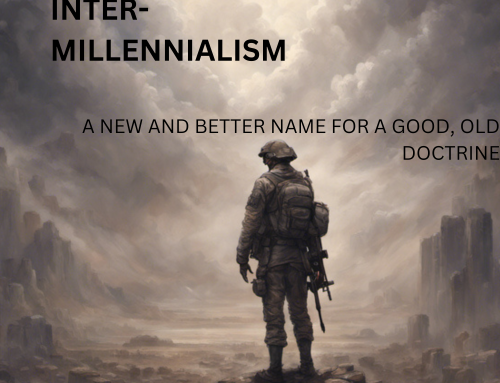The story of Christmas is one of stark contrast. In both the event of the Incarnation and the history of the holiday to commemorate it, very different things are brought into close proximity. Whether from gnostic philosophy, rigorous pietists, or totalitarian regimes, Christmas celebrations have been a continual source of criticism and controversy since the holiday’s beginnings. The conflicting visions of worship and worldview that come to bear during the Christmas season have, historically, been unable to peacefully coexist. This article explores the tumultuous history of what may be the world’s most famous holiday. In the process, we’ll see how the history of Christmas compares to the amazing event which is the impetus for its Christian celebration.
A preliminary note: The main inspiration for this article came from the book Christmas in the Crosshairs: 2000 Years of Denouncing and Defending the World’s Most Celebrated Holiday by Gerry Bowler. Much of the historical information in this article is drawn from his fascinating work –which I highly recommend.
The Beginning
In the development of major Christian “holy days,” Christmas was not the first on the scene. The commemoration of Christ’s Passion (Easter or Passover) was much more significant to the first few centuries of the Church. By the end of the second century, Easter was taken with such seriousness that a heated controversy broke out over its dating.[1] However, towards the third century, attention to the Nativity grew among early Church writers. The increased emphasis on the event of Christ’s physical birth may be linked to a reaction against the “dualistic” teaching of the Gnostics.
The Gnostics contended that material reality is entirely evil while only the spiritual is good. In their view, the dual forces of “evil matter” and “good spirit” are irreconcilable. So, all one can hope for is to escape this physical body and be reunited with the spiritual realm.[2] Such teaching is incompatible with the idea of a sinless Messiah who is both true (spiritual) God and true (physical) man. Yet, this is the very truth the Orthodox sought to defend. One way they did so was by emphasising Jesus’ physical birth.
Naturally, with increased focus on the event of the incarnation came interest in a specific date. Using various means of reckoning – astrological, allegorical, or calculated from scriptural chronology – by the early 200’s, many dates for Christ’s birth had been postulated. Gradually, two principal dates were settled upon: December 25 (primarily in the West) and January 6 (primarily in the East).
The Establishment
The origins and motive for what became Christmas, as celebrated on December 25, is a contested area of historical inquiry. There are two main theories that seek to explain the formal establishment of the holiday in the early 4th century: calculation and co-option. The theory of calculation suggests the timing of the holiday is founded upon a genuine attempt by Church leaders to calculate the actual date of Christ’s birth, through the various means mentioned above. The theory of co-option, on the other hand, suggests that the establishment of Christmas was an attempt to “Christianize” existing pagan festivals.
Although increasingly challenged in recent years, the second theory (co-option) has enjoyed much prominence since the 16th century for understandable reasons. December 25 was around the time of many midwinter festivals observed by the Pagans which commonly involved feasting, gift exchanges, and decoration using greenery. Moreover, in the year 273, the Roman Emperor Aurelian established a new holiday on December 25: the Birthday of the Unconquered Sun. While one might question why a religious group well-known for opposing pagan rituals would cozy-up to such festivals, the proximity of date makes the theory of co-option hard to resist. Correlation may not equal causation, but they can sure look a lot alike – especially to those inclined to squint their eyes in just the right way.
The Pagans
Whatever the true motive for establishing its date, a Christian holiday near the winter solstice was bound to run into challenges. From the start, there was a continual tension between Church leaders, who wanted to keep the Christian feast pure, and many common people who wished to continue their traditional (pagan) practices. One example, among many, is the archbishop of Constantinople speaking about the festivities in the year 380:
Let us not put wreaths on our front doors, or assemble troupes of dancers, or decorate the streets. Let us not feast the eyes, or mesmerize the sense of hearing, or make effeminate the sense of smell, or prostitute the sense of taste, or gratify the sense of touch. These are ready paths to evil, and entrances of sin. … But let us leave these things to the Greeks and to Greek pomp and festivals.[3]
This proximity between new Christian and old pagan practices was a widespread issue for the Church in the system of post-Constantinian sacralism.[4] However, the problem was especially clear to see at the time of Christmas celebrations. In this cultural stir-fry of new religion and old customs, it seems inevitable that pagan practice would begin to mix with Christian observance.
The Puritans
By the 16th century, it was evident that early Church leaders had largely lost in their battle to keep pagan traditions out of Christmas celebrations. This seemed especially clear to emergent groups of Calvinist Christians such as the Scottish Presbyterians and English Puritans. Having a strong adherence to the regulative principle of worship[5] and an aversion towards Roman Catholicism, it did not take much to convince them Christmas celebrations were unacceptable. Coupling these considerations with the apparent correlation between the holiday’s establishment and pagan feast days, along with clear pagan influence on certain elements of the celebration, many did not hesitate to denounce the festivities as mere idolatry.
Although a modified form of Christmas was still accepted by most Reformed churches of Continental Europe (as one of the “five evangelical feast days”[6]), it encountered much resistance in the English-speaking world. The celebration of Christmas was prohibited in Scotland in the late 16th century and was made illegal by the (Puritan-backed) English Parliament from 1646 until the restoration of the monarchy under Charles II in 1660. Across the Atlantic, Christmas was discredited or prohibited in many British colonies, and would not be widely accepted throughout America until the middle of the 19th century.
Here we see a stronger approach taken by Christian leaders in dealing with the influences of ostensibly impious traditions on Christian religious observance. The Puritans dealt with the conflict by prohibition – rejecting all practices not explicitly commanded by God. They were certainly not without good reasons for this. The history of the Roman Catholic Church demonstrates that it is very easy for foreign influences to creep in – not merely into holiday traditions, but also worship, theology, and philosophy.[7] The Puritans sought a pure and unchanging guide in God’s Word alone. But, to many modern sensibilities, replete with nostalgic ideas of family and fellowship in the Christmas season, their actions may appear rather harsh and joyless.
The Poets
For any who may be shocked to hear of the disdain Christmas received from many for some three centuries in the English-speaking world, it should be noted that, at the time, the celebration was often very different from the familiar domestic holiday of modern childhood delight. Before the religious objections of the 16th century, various strange and perhaps unseemly traditions were popular, such as the “feast of fools,” the “boy Bishop” and “abbots of unreason.”[8] From the 17th century on, in part due to its newly-downgraded status, the holiday became a time increasingly dominated by the rowdy revelry of intoxicated adults. The holiday, as popular culture knows it today, largely emerged from the work of a few 19th century American poets, writers, and artists who “sought to move Christmas away from its outdoor, proletarian, alcohol-fueled expressions and toward its celebration as a domestic, middle-class, child-centered holiday.”[9]
A large role in this American re-imagining of Christmas traditions was played by a newly adapted night-time gift-bringer – based on the traditions of Dutch immigrants. A newly Americanized Saint Nicholas would emerge and take America by storm. He was perhaps most powerfully popularized in Clement C. Moore’s poem “’Twas the Night Before Christmas.” Having transformed the holiday into a more innocent affair of family fun with gifts brought by a new Nicholas stripped of his bishop’s mitre, the holiday became much more attractive to American Protestants – even many theological heirs of 17th century Christmas-cancellers. With some rougher elements of yuletide revelry removed, and the danger (which Puritans dreaded) of paganism and Romanism reduced, it seemed the old holiday could be safely embraced.
The Dictators
In the 20th century, Christmas encountered enemies even more hostile than bands of Psalm-singing Scots, this time further East. With the rise of powerful totalitarian regimes such as the Third Reich and the Soviet Union, the holiday could not be left alone. Not only was Christmas a beloved European holiday with deep cultural roots, it was also an explicitly Christian annual phenomenon. Celebrating the birth of the Lord of lords does not fit well in a state with an absolutist Great Leader.
The solution to this incongruity in Nazi Germany was primarily one of co-option and transformation. A “Nazification” of the holiday was attempted by replacing many Christian (and especially Jewish) elements of Christmas literature, songs, and traditions with Nazi or neo-pagan themes. As one striking example, a new version of the famous German carol “Stille Nacht”[10] replaced Jesus with Adolf Hitler as the object of adoration.
The solution to the Christmas problem in the USSR, on the other hand, was mainly one of mockery and attempted abolition. In the early days under Lenin, a kind of “anti-Christmas” was established – complete with derisive songs, mock-trials, parodies of religious services, and the burning-in-effigy of Christ along with other religious figures. Later, under Stalin, after World War II, some Communist countries such as Albania banned religious Christmas observances on pain of imprisonment or death.
Christmas, and the subversive religion associated with it, stood in too stark a contrast with both regimes to allow any peaceful coexistence.
The Secular Consumers
This survey of Christmas’ turbulent history now brings us to modern-day North America. The struggle between conflicting forces centered around Christmastime has certainly not ceased. It is to this reality that we owe the phrase, “the War on Christmas.” Today, the holiday has grown into a massive commercial enterprise, yet, without entirely stripping away its Christian history and connotations. This pervasive and public display of Christianity is not acceptable to many secular groups, such as the ACLU and Freedom from Religion Foundation, who seek to limit religion to the private sphere. Opposition is continually raised to Christmas-related displays in public schools and on public property. The hyper-commercialization of the holiday is also of concern to many Christians who would urge us to “put Christ back in Christmas” lest we forget “the reason for the season.” Considering its history, it shouldn’t surprise us that such a struggle remains over the holiday. The truth is that Christmas remains controversial because Christianity is, and must be, controversial.
The Incarnate Word
The history of the Christmas holiday has been filled with tension as devout believers sought to maintain the purity of Christian worship amidst outside influences. It is a demonstration of the inevitable instability occurring when opposing religious and cultural forces are brought into proximity. There is no peaceful coexistence to be had, rather, there is a continual drift to a syncretistic co-mingling or a co-option or destruction of one force by another.
Yet, unlike the struggle of holiday history, in the Incarnation, we see something unique. In the person of Christ there is a reconciliation of the seemingly irreconcilable – the Infinite with the finite, the Creator with the creature, the Supernatural with the so-called natural, the Immaterial and Immortal Spirit with material flesh destined for the cross, that is, true God with true man. In the incarnate Christ exists one person with two natures, both in perfect harmony without comingling, destruction, or co-option of one by the other. The 4th century theologians understood this well when they formalized the doctrine of the “hypostatic union.” This reality was also understood by earlier leaders such as Ignatius of Antioch, who, writing to the Ephesian Church around 100 AD, said,
There is only one physician, who is both flesh and spirit, born and unborn, God in man, true life in death, both from Mary and from God, first subject to suffering, then beyond it, Jesus Christ our Lord.[11]
There is no gnostic dualism here, nor any modern materialistic or pantheistic monism.[12] In the Incarnation, the God who created the physical world as distinct from Himself entered His own creation without forfeiting His divinity. This is a feat of authoritative condescension for which no other religion or worldview has a category. It is a perfect image of unity in diversity and a perfect demonstration of both the power of God and the goodness of His plan for creation. It is only this One, the God-Man, who will end our struggle by bringing peace on earth and good will towards men. Yes, He will destroy his enemies, but He will also bring his people to God. He is the Saviour of the world. He has indeed accomplished the reconciliation of the seemingly irreconcilable. That is, He has brought together a holy God with sinful men.
The Incarnation of Christ is The Christmas Contrast, and it is worthy of our celebration.
[1] The controversy, known as the Quartodeciman controversy, is briefly discussed in Henry Chadwick, The Early Church p. 84-85
[2] See Michael J. Kruger, Christianity at the Crossroads p. 121-129 for a discussion of early “Christian” Gnosticism.
[3] Gregory Nazianzen, “Homily on the Nativity of Christ” cited in Gerry Bowler, Christmas in the Crosshairs p. 10
[4] “Sacralism” is a mixing of church and state government. The development of this system in Christianity began with the conversion of the Roman Emperor Constantine in the early 4th century, becoming well-established during the early Middle Ages. In Medieval Europe, to be a citizen of the state and a member of the Church was essentially the same thing.
[5] The regulative principle of worship argues that whatever is not commanded in scripture regarding Christian worship is forbidden. In its more rigorous flavors, it would include prohibition of musical instruments or extra-Biblical hymns in church service and any holy days apart from the Lord’s Day.
[6] The other four Evangelical feasts being Good Friday, Easter, Ascension, and Pentecost. This still represents a significant reduction from the traditional Roman Catholic calendar.
[7] For example, by the High Middle-Ages, ancient Greek philosophers such as Aristotle and Plato had become great authorities within the Roman Church.
[8] I will leave it to the reader to look up what these customs entailed. See Gerry Bowler, Christmas in the Crosshairs p. 19-21
[9] Gerry Bowler, Christmas in the Crosshairs p. 48
[10] English “Silent Night”
[11] Ignatius of Antioch, Ephesians 7.2 translation by Michael W. Holmes The Apostolic Fathers 3rd Ed.
[12] By “monism” I mean the belief that “all is one.” In Materialism, all is matter. In Pantheism, all is god.



